Perdue Farms Bundle
How Does Perdue Farms Thrive in the Poultry Industry?
For over a century, Perdue Farms has been a powerhouse in the U.S. food sector, particularly known for its poultry products. The company's strategic shift towards no-antibiotics-ever (NAE) chicken production highlights its responsiveness to consumer demands and commitment to sustainable practices. This evolution underscores Perdue's position as a leader in responsible food production, setting it apart in a competitive market.
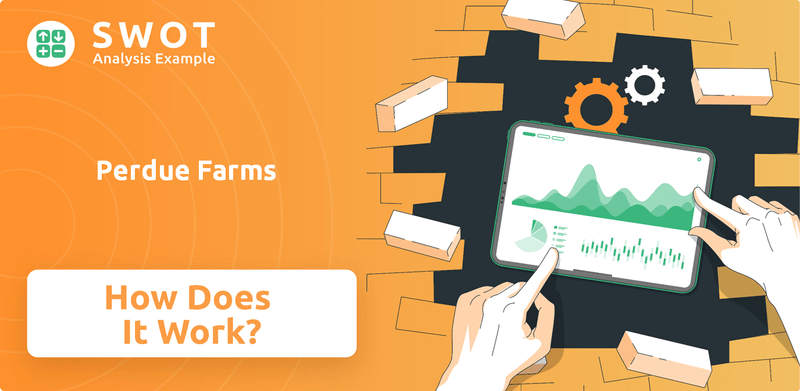
Delving into Perdue Farms' operations is essential for understanding its market position and future potential. From its integrated poultry and pork production to its grain-based food products, Perdue's diverse portfolio caters to a wide consumer base. To gain deeper insights, consider exploring a detailed Perdue Farms SWOT Analysis to understand its strengths, weaknesses, opportunities, and threats within the competitive landscape of the poultry industry, including its chicken production practices and overall financial performance.
What Are the Key Operations Driving Perdue Farms’s Success?
Perdue Farms creates and delivers value through its vertically integrated approach to poultry and pork production, alongside its grain-based food products. The company's core offerings include fresh and frozen chicken and turkey products, further processed poultry and pork items, and various grain products. These offerings cater to a wide range of customer segments, from individual consumers through retail channels to large-scale foodservice providers.
The operational processes at Perdue are extensive, beginning with genetic selection and hatchery operations, followed by raising animals on company-owned or contract farms. This integrated system allows Perdue to maintain strict control over animal welfare, feed quality, and overall production standards. Manufacturing involves processing, packaging, and preparing meat products, while sourcing extends to acquiring grains for feed and other ingredients for its food products. Logistics and distribution networks are critical, ensuring products reach retailers and foodservice clients efficiently across the country. The company's commitment to no-antibiotics-ever (NAE) poultry, alongside its investments in sustainable farming practices, represents a key differentiator.
Perdue's focus on animal welfare and environmental stewardship is integrated into its operational strategy, aiming to meet increasing consumer demand for responsibly produced food. This commitment translates into customer benefits such as perceived healthier and higher-quality products, contributing to brand loyalty and market differentiation. For those interested in the company's growth trajectory, an analysis of the Growth Strategy of Perdue Farms provides further insights.
Perdue Farms is a major player in the chicken production industry. The company's operations are heavily focused on the efficient and responsible raising of chickens, from hatchery to processing. This focus is a key aspect of how Perdue Company operates.
Perdue Farms utilizes a vertically integrated model. This means that the company controls various stages of production, including breeding, farming, processing, and distribution. This integration allows for greater control over quality and efficiency.
Food processing is a critical component of Perdue's operations. The company processes a large volume of chicken and other products. These processes ensure that products meet safety and quality standards.
Perdue Farms has increased its focus on sustainability. The company has implemented various initiatives aimed at reducing its environmental impact. These efforts are increasingly important to consumers.
Perdue Farms' operations are multifaceted, involving various stages from farm to table. The company's commitment to quality, animal welfare, and sustainability is central to its value proposition. Perdue chicken production is a significant part of its business.
- No-Antibiotics-Ever (NAE) Poultry: A significant portion of Perdue's poultry production adheres to NAE standards, reflecting a commitment to consumer health.
- Animal Welfare: Perdue invests in animal welfare practices, including improved housing and care.
- Sustainable Farming: The company has initiatives focusing on reducing its environmental footprint, such as water conservation and waste reduction.
- Supply Chain: Perdue manages a complex supply chain to ensure products reach consumers efficiently.
Perdue Farms SWOT Analysis
- Complete SWOT Breakdown
- Fully Customizable
- Editable in Excel & Word
- Professional Formatting
- Investor-Ready Format
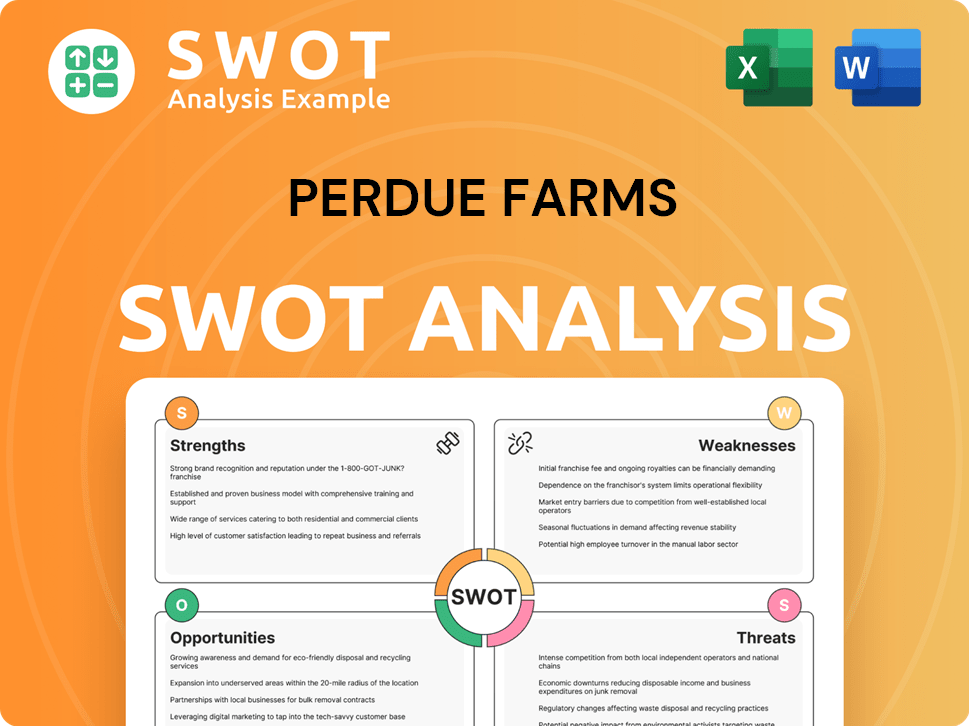
How Does Perdue Farms Make Money?
Perdue Farms generates revenue primarily through the sale of its poultry, pork, and grain-based food products. The company’s revenue streams are diversified, with a significant portion coming from its poultry division, including chicken and turkey products. While specific revenue figures are not publicly available, the poultry segment consistently represents the largest part of its sales.
The company’s monetization strategies involve direct product sales through retail channels, leveraging its established brand recognition. Additionally, Perdue supplies products to foodservice operators and commercial entities. Grain operations also contribute to revenue by selling grains and feed ingredients.
Perdue has expanded its revenue sources through acquisitions and the development of new product lines. This includes brands like Perdue Premium Pork and Niman Ranch, which target niche markets with higher price points. These expansions reflect a strategy to diversify its revenue base and capture different consumer segments.
Perdue Farms, a major player in the poultry industry, uses several strategies to generate revenue. The company’s main source of income comes from selling its chicken, turkey, and pork products. Perdue also sells grains and feed ingredients, supporting both its internal needs and external customers. For more insights, you can explore the Marketing Strategy of Perdue Farms.
- Poultry Sales: The largest portion of revenue comes from chicken and turkey products, including fresh, frozen, and prepared items.
- Retail Channels: Perdue sells branded products through various retail outlets, capitalizing on its brand recognition.
- Foodservice: Supplying products to restaurants, institutions, and other commercial entities is a significant revenue stream.
- Grain Operations: The sale of grains and feed ingredients contributes to revenue, supporting both internal operations and external customers.
- Premium Brands: The company has expanded into niche markets with brands like Perdue Premium Pork and Niman Ranch, which offer higher-priced products.
Perdue Farms PESTLE Analysis
- Covers All 6 PESTLE Categories
- No Research Needed – Save Hours of Work
- Built by Experts, Trusted by Consultants
- Instant Download, Ready to Use
- 100% Editable, Fully Customizable
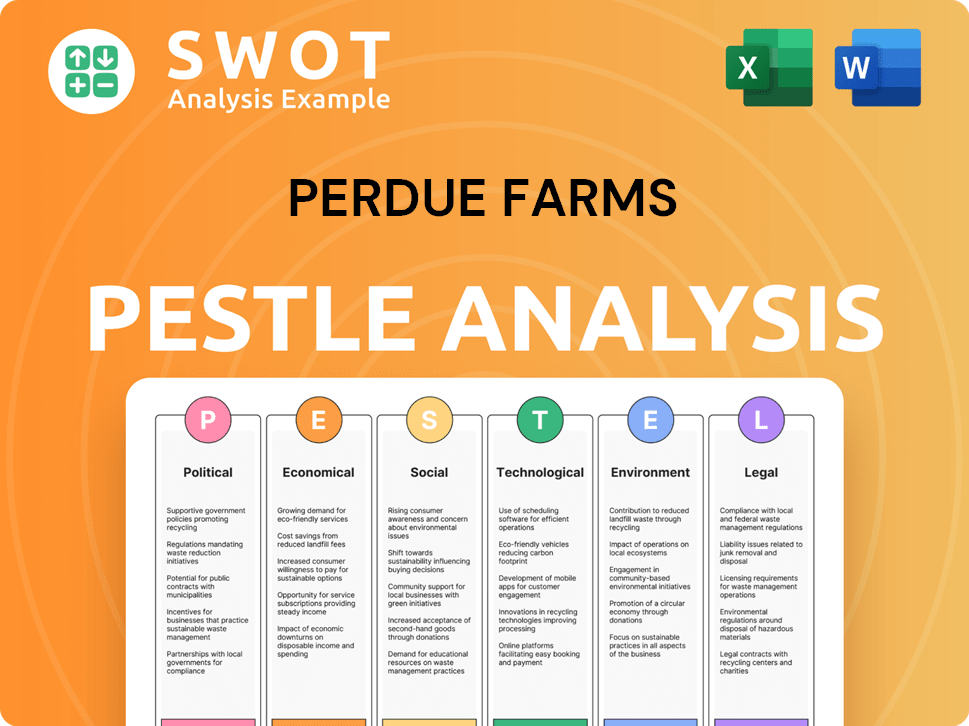
Which Strategic Decisions Have Shaped Perdue Farms’s Business Model?
Perdue Farms has a rich history marked by key milestones that have shaped its operations and financial performance. A significant strategic move has been its leadership in transitioning to no-antibiotics-ever (NAE) chicken production, a process that began over a decade ago. This commitment has positioned Perdue as a pioneer in meeting evolving consumer demands. The company has also expanded its organic and free-range product lines, solidifying its market position in premium segments.
Operational challenges include navigating fluctuating feed costs and managing supply chain disruptions. Perdue has responded by investing in supply chain resilience and optimizing its production processes. Its competitive advantages include strong brand recognition and economies of scale from its integrated operations. Perdue continues to adapt to new trends, such as the increasing demand for plant-based proteins, by exploring relevant market opportunities.
The company's vertical integration, from genetics to processing and distribution, provides a significant competitive edge by allowing greater control over quality and efficiency. This approach, combined with its focus on sustainability and animal welfare, has helped Perdue Farms maintain a strong position in the poultry industry. For more insights into the company's strategic direction, consider reading about the Growth Strategy of Perdue Farms.
Perdue Farms has achieved several key milestones, including its early adoption of no-antibiotics-ever (NAE) practices. The company has also expanded its product lines to include organic and free-range chicken. These moves reflect Perdue's commitment to meeting evolving consumer preferences and maintaining a competitive edge in the market.
Strategic moves by Perdue Farms include a focus on sustainable practices and animal welfare. The company has invested in supply chain resilience to mitigate disruptions. These strategies aim to enhance operational efficiency and meet consumer demands for responsibly produced chicken.
Perdue's competitive advantages include strong brand recognition and economies of scale. Vertical integration, from genetics to distribution, provides greater control over quality and efficiency. These factors enable Perdue to maintain a strong market position and respond effectively to industry challenges.
Perdue faces operational challenges such as fluctuating feed costs and supply chain disruptions. Adapting to changing regulatory landscapes in the agricultural sector is also a key concern. The company addresses these challenges through strategic investments and process optimizations.
In recent years, the poultry industry has seen significant fluctuations due to various factors. Feed costs, a major expense for companies like Perdue Farms, have been impacted by global commodity prices. Market data indicates a growing consumer preference for antibiotic-free and organic chicken products, influencing Perdue's strategic decisions.
- The poultry industry in the United States generated approximately $55.7 billion in sales in 2023.
- The demand for organic chicken products has increased, with a growth rate of about 10% annually.
- Perdue Farms has invested significantly in its supply chain, with spending reaching over $100 million in 2024 to enhance resilience.
- The company's focus on animal welfare and sustainability has led to a strong brand reputation, positively impacting consumer perception.
Perdue Farms Business Model Canvas
- Complete 9-Block Business Model Canvas
- Effortlessly Communicate Your Business Strategy
- Investor-Ready BMC Format
- 100% Editable and Customizable
- Clear and Structured Layout
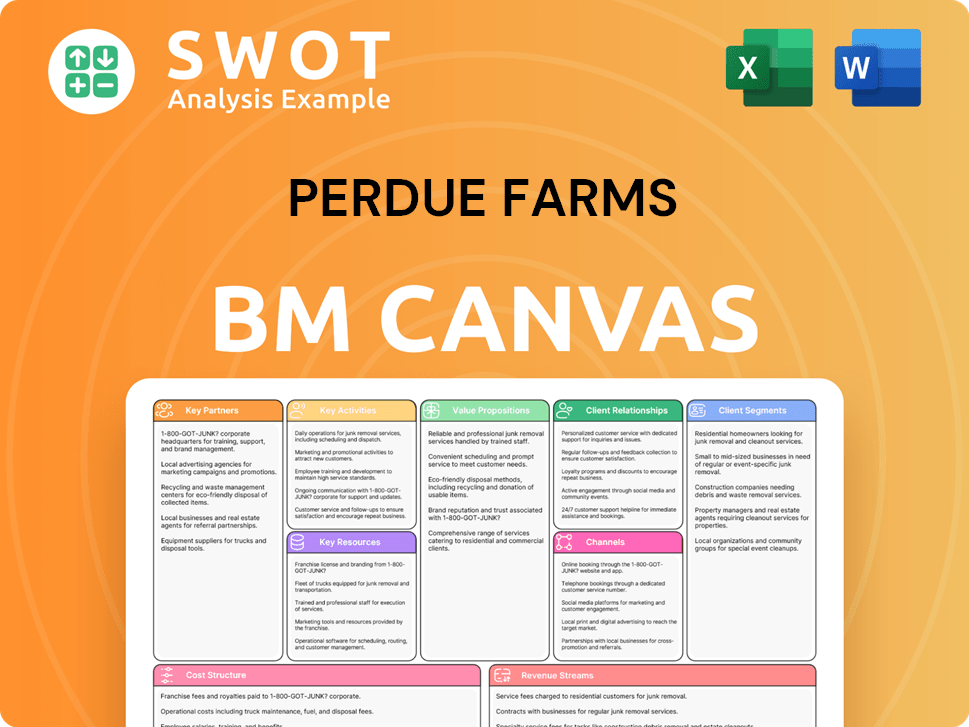
How Is Perdue Farms Positioning Itself for Continued Success?
Perdue Farms holds a significant position within the U.S. poultry industry, standing as a major player in chicken production. Its extensive distribution network and brand recognition contribute to its strong presence in both retail and foodservice sectors. The company competes with other industry giants, differentiating itself through its focus on animal welfare, sustainability, and its premium product offerings, like No Antibiotics Ever (NAE) chicken.
The company faces various risks, including fluctuating commodity prices for feed grains, potential disease outbreaks, and increasing regulatory scrutiny. Consumer preferences, such as the growing interest in plant-based diets, also pose a long-term challenge. Despite these hurdles, Perdue Farms is actively pursuing strategic initiatives focused on sustainable agriculture and product development to maintain its market position.
Perdue Farms is among the top poultry producers in the United States. It has a substantial market share, though specific figures fluctuate. The company's brand loyalty and wide distribution network support its strong presence in both retail and foodservice.
Key competitors include Tyson Foods and Pilgrim's Pride. Perdue differentiates itself through its emphasis on animal welfare, sustainability, and premium product offerings, such as NAE chicken. Competition is fierce, requiring continuous innovation and efficiency.
Perdue faces risks such as volatile commodity prices for feed grains, potential disease outbreaks, and increasing regulatory scrutiny. Evolving consumer preferences, like the rise of plant-based diets, also pose a long-term challenge. These factors can impact profitability.
The company's future involves continued investment in responsible food production, exploring new product categories, and potential market expansion. Leadership is committed to sustainable practices and meeting changing consumer demands. This indicates a forward-looking strategy.
To navigate challenges, Perdue Farms focuses on strategic initiatives such as sustainable agriculture and product development. The company is adapting to changing consumer preferences by innovating and expanding its product offerings. This includes exploring new categories and enhancing its commitment to responsible food production.
- Investment in sustainable practices.
- Focus on product innovation to meet consumer demands.
- Potential for market expansion.
- Emphasis on animal welfare and environmental stewardship.
Perdue Farms Porter's Five Forces Analysis
- Covers All 5 Competitive Forces in Detail
- Structured for Consultants, Students, and Founders
- 100% Editable in Microsoft Word & Excel
- Instant Digital Download – Use Immediately
- Compatible with Mac & PC – Fully Unlocked
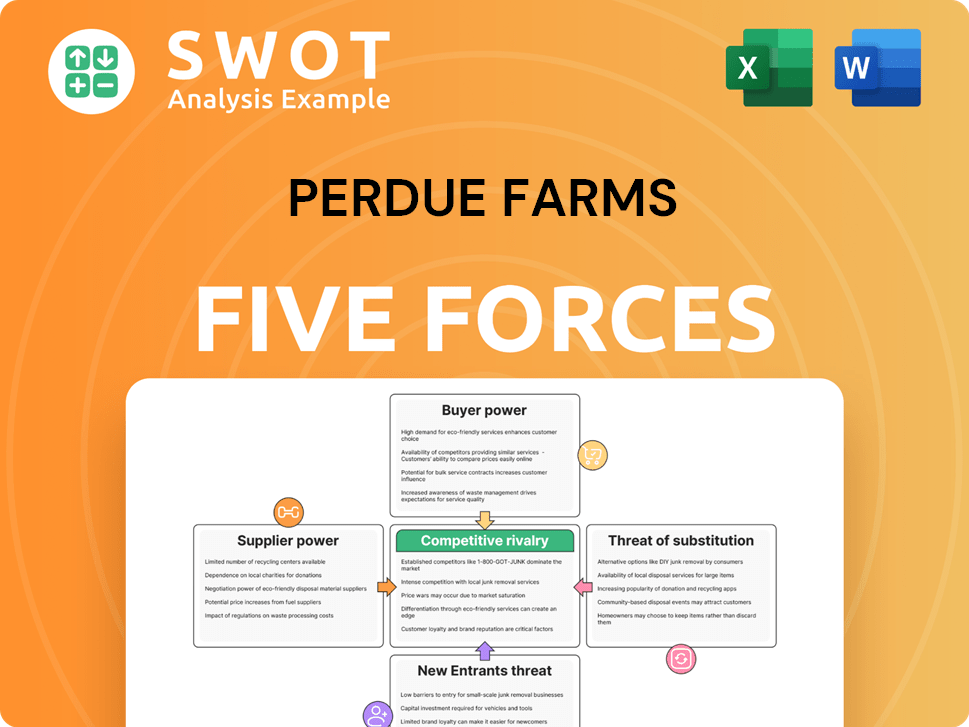
Related Blogs
- What are Mission Vision & Core Values of Perdue Farms Company?
- What is Competitive Landscape of Perdue Farms Company?
- What is Growth Strategy and Future Prospects of Perdue Farms Company?
- What is Sales and Marketing Strategy of Perdue Farms Company?
- What is Brief History of Perdue Farms Company?
- Who Owns Perdue Farms Company?
- What is Customer Demographics and Target Market of Perdue Farms Company?
Disclaimer
All information, articles, and product details provided on this website are for general informational and educational purposes only. We do not claim any ownership over, nor do we intend to infringe upon, any trademarks, copyrights, logos, brand names, or other intellectual property mentioned or depicted on this site. Such intellectual property remains the property of its respective owners, and any references here are made solely for identification or informational purposes, without implying any affiliation, endorsement, or partnership.
We make no representations or warranties, express or implied, regarding the accuracy, completeness, or suitability of any content or products presented. Nothing on this website should be construed as legal, tax, investment, financial, medical, or other professional advice. In addition, no part of this site—including articles or product references—constitutes a solicitation, recommendation, endorsement, advertisement, or offer to buy or sell any securities, franchises, or other financial instruments, particularly in jurisdictions where such activity would be unlawful.
All content is of a general nature and may not address the specific circumstances of any individual or entity. It is not a substitute for professional advice or services. Any actions you take based on the information provided here are strictly at your own risk. You accept full responsibility for any decisions or outcomes arising from your use of this website and agree to release us from any liability in connection with your use of, or reliance upon, the content or products found herein.